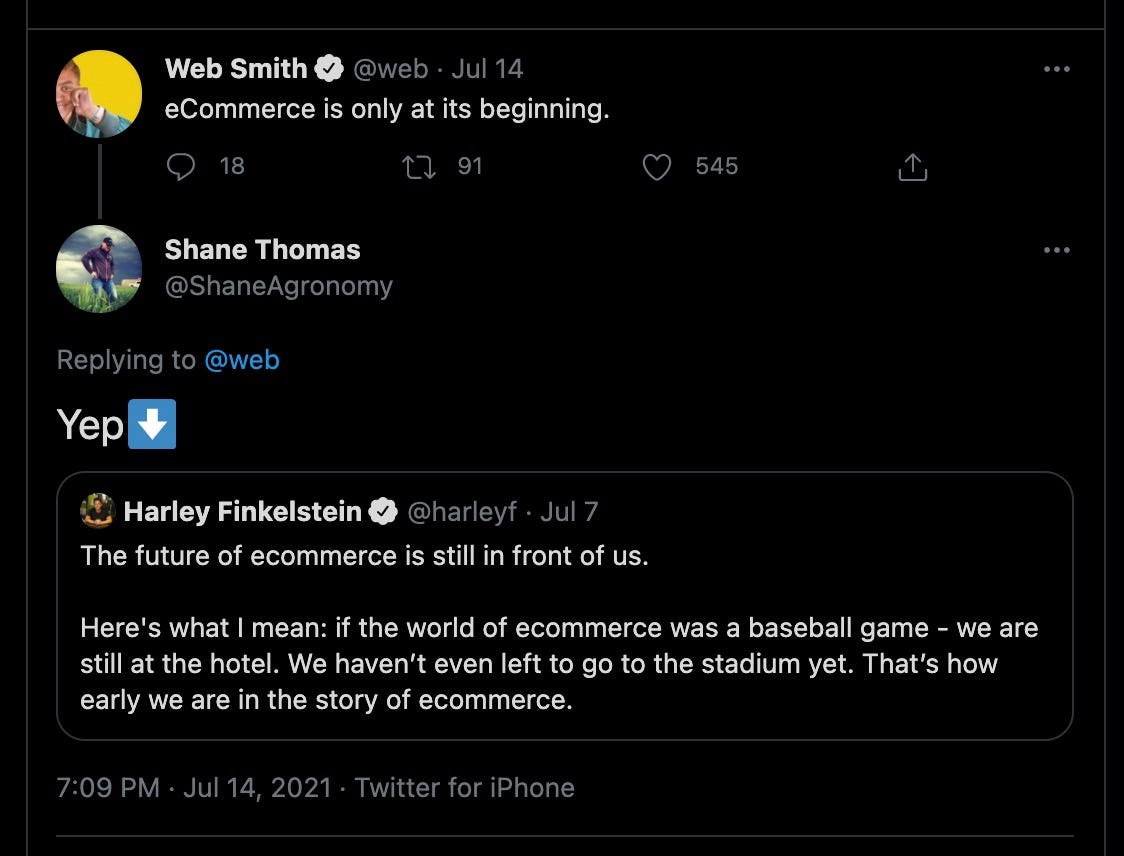Tighten the packer feedback loop
Prime Future 60: the newsletter for innovators in livestock, meat, and dairy
New to Prime Future? Welcome!
In early 2020 I went down the rabbit hole of exploring what D2C might mean for the meat business. Today I want to revisit some ideas from way back then but with the benefit of a little hindsight after the trend wildly accelerated during the pandemic. This tweet sets the directional stage for the obviousness that D2C is, and will continue to be, a thing for all segments, including meat:

So here’s the quick recap of my no longer provocative hypothesis:
Hypothesis: Direct to Consumer (D2C) business models will be a high growth sales channel for all meat & poultry companies within 5 years.
And to capitalize on the D2C trend, packers must get serious about building capability…soon.
For those who might say this market is still too small for packers to pay attention yet, remember in part 1 we talked about the Innovator’s Dilemma. Quick summary:
“Established companies see the early trends of new markets, they are just not structured or incentivized to act on them. Leaders at established companies must focus on market share and profitability of today’s largest customers & segments….not tomorrow’s.”
Given that D2C is definitively not going to suddenly be the largest sales segment overnight, why should packers focus there?
There are 2 obvious reasons:
If COVID has taught us anything, its that a large segment of consumers are comfortable ordering online and want more ways to secure access to protein.
As more companies seek to build brands and move closer to the consumer in order to increase margin, D2C presents an obvious opportunity.
Now let’s transition to the still relevant & under-appreciated elements around D2C, starting with this:
There’s a less obvious reason for packers to bet on D2C, one that could impact the packer’s ability to serve their entire customer portfolio.
The strategic reason to engage in D2C is to drastically increase visibility into consumer behavior.
To illustrate this point, here’s a case study from the insurance industry.
Back in the day insurance carriers built out the agent distribution system, so products and processes were built for selling through the distribution system. The carriers receive data related to policies sold. Now, many carriers are trying to figure out how to layer digital into the customer experience but its….clunky.
Contrast this with Lemonade, the homeowners insurance startup with a digital first experience for buyers that’s grown from $0 to $100M revenue in 3 years. As a digital first experience, shoppers not only buy their policy online, they also file claims online, most of which are settled with incredible speed.
So what? In its few years in existence, Lemonade has captured data about buyer behavior that provides them better insight to their buyer than the mega companies who have been in existence for decades.
Take <insert 100+ yr old insurance company>. That company captures data about buyers who purchased a policy. That’s it.
Meanwhile Lemonade is able to understand exactly how buyers moved through every inch of the buying process, such as:
What options did they consider? Did they select one before going back to select another?
Which options did the buyer take the most time to select?
How far did the buyer get in the process before dropping out entirely?
And that’s just the tip of the iceberg.
This treasure trove of data informs Lemonade’s understanding of their target customer including buying behavior, which then informs Lemonade’s ability to improve the customer experience through better processes AND better products. The power of a shortened feedback loop.
Now let’s do the meat industry. Packers get point of sale data from retailers that tells them what a customer bought…that’s it. Meanwhile <name your digital first D2C company> understands the buyer’s behavior at a granular level, including which cuts a customer almost bought but didn’t, which cuts a customer bought once but never repeated, etc, etc, etc.
Think about how a packer could build a compelling competitive advantage in terms of marketing and product development not just in their D2C channel, but across retail and foodservice as well. Unlocking the power of a shortened feedback loop could power innovation and growth across the entire customer portfolio.
The packers are now dabbling with their 2 primary options:
Supply a growing D2C platform as a customer
Packers are approaching this opportunity differently, but it doesn’t take a crystal ball to see that this trend is here to stay.
My curiosity is not in how packers continue engaging this sales channel, but how the sales channel will impact their broader business via shortened feedback loops…and how might those impacts flow upstream to producers.
Here’s the original 3 part series on D2C & what it could mean for packers and producers:
I’m interested in all things technology, innovation, and every element of the animal protein value chain. I grew up on a farm in Arizona, spent my early career with Elanco, Cargill, & McDonald’s before moving into the world of early stage startups.
I’m currently on the Merck Animal Health Ventures team. Prime Future is where I learn out loud. It represents my personal views only, which are subject to change…’strong convictions, loosely held’.
Thanks for being here,
Janette Barnard


